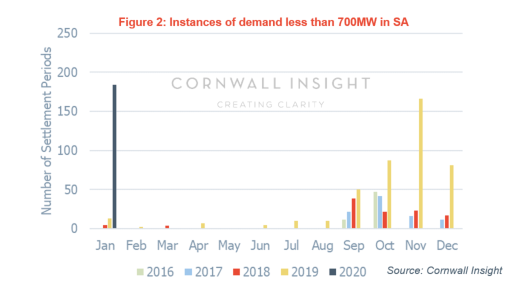On the 6 February, AEMO issued market notice 73857 in response to the enduring islanding of the SA network. The notice informed the market that when South Australian (SA) demand falls under 800MW several generators, including more than 500MW of wind and 300MW of solar will be constrained down to zero. In a later notice, AEMO subsequently revised the low demand trigger down to 700MW.
The number of sub-800MW periods of demand in SA is growing; in fact, research from Cornwall Insight Australia highlights that it is increasing exponentially. The number of periods has risen from just under 400 in 2018 to more than 850 in 2019. The number of sub-700MW periods has also increased by just under 400% over the same period from 110 to 431. Shown in the below graphs.
In the first month of 2020, SA saw 184 instances of sub-800MW, more than the total number of times for 2016 and four times more than January 2019.


Ben Cerini Principal Consultant at Cornwall Insight Australia, said:
“The periods of lowest demand in SA typically occurs during the middle of mild sunny days (September – January), when rooftop solar is beginning to ramp up their output, but the weather is not yet hot enough to require air conditioning. Since 2017, 96%-98% of all settlement periods where demand was less than 800MW in SA occurred between 10 am and 5 pm. When this is reduced to 700MW, 99%-100% of all periods fall between 10 am to 4 pm.
“Historically, February has only seen a handful of low demand periods, averaging ten 800MW periods since 2017 and only two 700MW occurrences since 2016 (both in 2019). As a result, generators would not necessarily expect to be curtailed often between now and the beginning of September 2020. However, given the sharp rise in the number of low demand periods in January, we may see more significant increases in February if the milder weather holds.
“The real issue is whether these curtailments will persist long-term as AEMO tests participants’ responses to this market intervention. It remains to be seen whether this method for rectifying system issues is an alternative to developing market mechanisms such as ‘demand turn up’ or utilising more significant portions of lower Frequency Control Ancillary Services (FCAS). Given the current market structure, it appears that in the short-term price-hedged renewable players will be the most at risk during these curtailment periods.”

